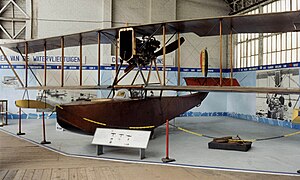FBA Type H
| Type H | |
|---|---|
 |
|
| FBA Type H flying boat on display at the Royal Museum of the Armed Forces and of Military History, Brussels, Belgium | |
| Role | Reconnaissance flying boat |
| Manufacturer | FBA |
| Designer | Louis Schreck |
| First flight | 1915 |
| Introduction | 1916 |
| Status | one example preserved |
| Number built | ca. 2000 |
The FBA Type H was a French reconnaissance flying boat produced in large numbers in France and Italy during World War I by Franco-British Aviation.
A development of the FBA Type A, the Type H shared the same basic pusher biplane configuration, but was a larger and heavier machine based on a Donnet-Lévêque design and powered by a water-cooled engine in place of the earlier type's rotary. Most French-built aircraft had Hispano-Suiza 8A variants with powers of 150 or 170 hp (112 or 127 kW), though a minority had 160 hp (119 kW) Lorraine 8Ns. These were all V-8 engines. Some Italian built Type Hs also used the higher-power Hispano motor but more had 180 hp (134 kW) Isotta Fraschini V.4B or 150 hp (142 kW) engines of the same make, both six-cylinder inlines.
The aircraft was a two bay biplane with the smaller span lower wing positioned just above the central fuselage on four supporting struts. There was no stagger and simple parallel interplane struts separated the bays; an extra, outward leaning pair supported the overhanging upper plane on each side. Ailerons were mounted only on this upper wing. The single pusher engine was mounted on struts just below the upper wing, its two blade propeller turning in a cut-out in the wing trailing edges.
The hull of the Type H was, like that of its predecessors, a single step design. A pair of flat bottomed floats, mounted below the outer interplane struts, stabilized the aircraft on the water. Two flight crew members were accommodated side-by-side and a front gunner sat separately in the nose. The rounded, finless rudder mounted above the high tailplane distinguished the Type H from earlier FBA flying boats, which had angular vertical tails.
...
Wikipedia
